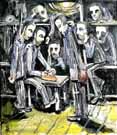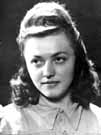
|
|
|

|

|

|

|
|
Click on an image to see a larger, more detailed picture.
|
|
|
|
|
| 1942: The "Final Solution" |

|
pg. 376 |

|
|
|
|
| |
 Extra food was, to say the least, a significant event in the daily lives of starved camp inmates. "Dividing the Bread in the Concentration Camp," a painting by Plaszow labor-camp survivor Joseph Bau, suggests the keen interest roused by unexpected windfalls.
Extra food was, to say the least, a significant event in the daily lives of starved camp inmates. "Dividing the Bread in the Concentration Camp," a painting by Plaszow labor-camp survivor Joseph Bau, suggests the keen interest roused by unexpected windfalls.
Photo: Gerald Gustafson Photography
|
 One of the things that distinguished Orthodox Jewish men was their beards. Many, such as Rabbi Avraham Grodzensky (pictured), shaved their beards, violating Orthodox traditions. He likely shaved it because Othodox men were more likely to be chosen and abused, even on the streets.
One of the things that distinguished Orthodox Jewish men was their beards. Many, such as Rabbi Avraham Grodzensky (pictured), shaved their beards, violating Orthodox traditions. He likely shaved it because Othodox men were more likely to be chosen and abused, even on the streets.
Photo: Main Commission for the Investigation of Nazi War Crimes / United States Holocaust Memorial Museum Photo Archive
|
 Women Camp Guards
Women Camp Guards
The SS included within its ranks female volunteers who guarded female inmates at the concentration and death camps. Relatively few in number, these women sometimes exceeded their male counterparts in cruelty. Irma Grese, nicknamed the "Belle of Auschwitz," became a guard as a teenager and rose through the hierarchy to oversee nearly 20,000 women prisoners. Grese took special pleasure in watching the doctors at Auschwitz perform disfiguring surgeries on women. The Ravensbrück, Germany, concentration camp for women contained a training camp to prepare women to become camp supervisors. Some 3500 women who trained at Ravensbrück served as guards there or at other camps. Hildegard Mende (pictured) worked at Theresienstadt. While a few guards exhibited kindness toward their prisoners, most followed the harsh camp rules, and beat and humiliated their prisoners. Few sought to intercede on inmates' behalf. Some guards even competed with one another in cruelty, believing that was the route to promotion and respect from their male superiors. One prisoner reported that women were even worse than men in commanding their dogs to brutally attack inmates. Another prisoner attested that a female guard requested permission to watch the gassings at Auschwitz, a pastime she particularly enjoyed.
Photo: Terezin Memorial Museum / United States Holocaust Memorial Museum Photo Archive
|
|

|

|

|

|
 October 1, 1942: In Luków, Poland, Jewish Council member David Lieberman is told by German authorities that money he has collected to ransom Lublin's Jews is useless, and deportations will continue, whereupon Lieberman tears the money to pieces and slaps the German official in the face. Ukrainian guards kill Lieberman immediately, and 4000 of the Jews Lieberman had hoped to protect are deported to the Treblinka extermination camp, where they are gassed.
October 1, 1942: In Luków, Poland, Jewish Council member David Lieberman is told by German authorities that money he has collected to ransom Lublin's Jews is useless, and deportations will continue, whereupon Lieberman tears the money to pieces and slaps the German official in the face. Ukrainian guards kill Lieberman immediately, and 4000 of the Jews Lieberman had hoped to protect are deported to the Treblinka extermination camp, where they are gassed.
|
 October 1-2, 1942: Hundreds of Jews escape the Ukrainian town of Luboml but are quickly hunted down. In all, some 10,000 of the town's Jews are killed.
October 1-2, 1942: Hundreds of Jews escape the Ukrainian town of Luboml but are quickly hunted down. In all, some 10,000 of the town's Jews are killed.
|
|
|
|
|
| 1942: The "Final Solution" |

|
pg. 376 |

|
|
The Holocaust Chronicle
© 2009 Publications International, Ltd.
|
|
